On this week's Naked Scientists, we explore the engineering and materials science that will give rise to the future of transport! We find out how jet engine parts grown as a single crystal of superalloy will make flights more efficient, and how clever computer control make it easier for trucks to turn. Plus, pain-free injections for the needle-phobic, Boogie with birds and the synthesised sound of Swine Flu proteins. In Kitchen Science, Ben and Dave look back over 7000 years to seek the science of the wheel...
In this episode

Better way to fight flu
Scientists have developed a pain-free injection system to immunise people against influenza. Writing in the current edition of PNAS, Emory University researcher Richard Compans and his colleagues describe how a system of microneedles, each measuring less than a tenth of the diameter of a traditional small hypodermic needle and designed just to penetrate the surface of the skin, can be used to protect mice against fataldoses of the flu. The tiny injection needles are mounted in a line on a plastic carrier and coated with a vaccine solution containing chemically-inactivated components of flu virus.
 The needles are then allowed to dry, in which form they are chemically stable, and may then be kept until needed. Vaccination is achieved by pressing the needles against the skin,which transfers the virus material from the needles. Tests on mice showed that within fourteen days the animals produced equivalent levels of antibodies to a test vaccine as animals that received traditional intramuscular flu injections. The team were also able to protect mice against a potentially fatal infection with a strain of influenza that killed unimmunised, control animals.
The needles are then allowed to dry, in which form they are chemically stable, and may then be kept until needed. Vaccination is achieved by pressing the needles against the skin,which transfers the virus material from the needles. Tests on mice showed that within fourteen days the animals produced equivalent levels of antibodies to a test vaccine as animals that received traditional intramuscular flu injections. The team were also able to protect mice against a potentially fatal infection with a strain of influenza that killed unimmunised, control animals.
The system works by exploiting the relatively large number of so-called professional "antigen presenting cells" (APCs) including Langerhans and dendritic cells which are present in the skin.These take up the injected materal and encourage the immune system to mount a response. And for inoculations that require larger doses of vaccinematerial or antigen, which some have suggested might be required for bird flu (H5N1) vaccines, the number of needles can simply be increased to boost the dose. But the major benefit of this new system is that the vaccine material on the needles is dry, meaning that unlike many traditional vaccines it doesn't need to remain refrigerated, making it potentially very useful for use in developing countries. Also, because the system does not resemble a traditional syringe and needle, and is also painless, it should help needle-phobics to overcome their fear of injections.
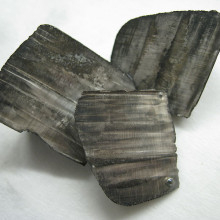
Lithium in tap water cuts suicide rates
Scientists in Japan have found a strong link between higher levels of the metal lithium in tap water and a reduced incidence of suicide.
Hirochika Ohgami and Takeshi Terao from Oita University led a team who measured the levels of lithium in the tap water of 18 municipalities of a region of Japan called Oitra and compared that against the rates of suicide among the million people who live there. The study published in the British Journal of Psychiatry shows that between 2002 and 2006, in areas where lithium levels were highest, suicide rates were significantly lower.
People with serious mood disorders like bipolar disorder are already treated with high doses of lithium to try and stabilise their moods, but this study shows that much lower doses, perhaps accumulating in the brain over time, may also have a positive impact on suicide rates.
The amounts of lithium in the drinking water ranged from 0.7 to 59 micrograms per litre, and this study raises the issue of whether lithium should be added on large scales to drinking water. That sort of mass and involuntary delivery of medicine is something that will no-doubt stimulate hot debate. The authors emphasize that it is still very early days, and that wider scale studies are now urgently needed to understand more about the affects of lithium in drinking water especially since it is known to have nasty side effects and can be toxic at higher doses.
Another recent study has shed light on how exactly lithium affects the brain and helps stabilize bipolar disorder, something scientists have been quite understood. Professor Adrian Harwood of Cardiff School of Biosciences in the UK, led a study in the journal Disease Models and Mechanisms which has pinpointed a possible pathway that lithium may act through.
Laboratory tests of cell cultures has found that by inhibiting an enzyme called inositol monophosphatase (IMPase), lithium reduces the production of a molecule called PIP3 which is known to play an important role in controlling brain cell signalling. A certain variant of the gene or IMPase, has been previously linked to people with bipolar disorder and it could be that lithium is somehow counteracting changes in that gene. The precise mechanism remains to be discovered but this study points the way for future studies.
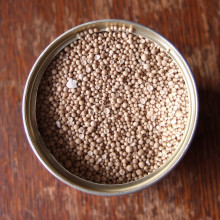
Interfering with inflammation
US scientists have developed a method to selectively shut off genes linked to inflammation all around the body. Writing in this week's Nature, University of Massachusetts researcher Michael Czech and his colleagues describe how they have produced gene-silencing particles which are orally active and can block the production of inflammatory signals linked to diseases including rheumatoid arthritis and septic shock. Surprisingly, part of the key to the breakthrough was baker's yeast cells, which coat themselves with a sugary layer of a chemical called beta-1,3-D-glucan which is itself recognised and picked up by inflammatory cells called macrophages. The team found that by treating yeast cells with acid and solvent solutions they were able to dissolve away all but this outer layer, which remained like hollow husks, each about one five hundreth of a millimetre across.
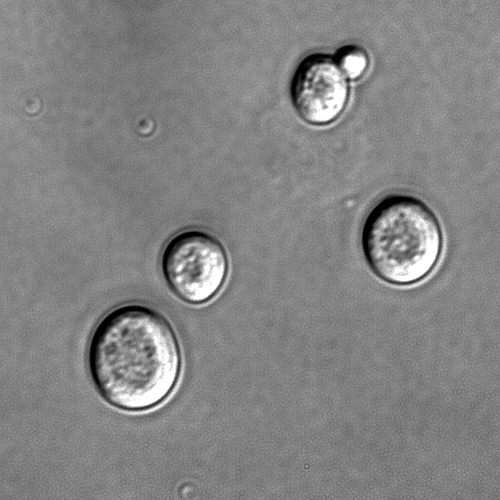 These they then could then refill with short segments of genetic material called interfering RNA molecules. These are the genetic mirror images of certain cellular genes and when they enter cells they shut off their target gene by binding to the gene product and causing it to be broken down. In this case the researchers used interfering RNA molecules directed against two inflammatory genes called tnf-alpha and map4k4. When they fed the particles to mice, macrophages lining the animals' digestive tracts recognised the beta-1,3-D-glucan on the surface and picked them up. Once inside, rather like the Trojan Horse, the particles then discharged their gene silencing contents, shutting of the target genes in these cells.
These they then could then refill with short segments of genetic material called interfering RNA molecules. These are the genetic mirror images of certain cellular genes and when they enter cells they shut off their target gene by binding to the gene product and causing it to be broken down. In this case the researchers used interfering RNA molecules directed against two inflammatory genes called tnf-alpha and map4k4. When they fed the particles to mice, macrophages lining the animals' digestive tracts recognised the beta-1,3-D-glucan on the surface and picked them up. Once inside, rather like the Trojan Horse, the particles then discharged their gene silencing contents, shutting of the target genes in these cells.
The researchers think that it may be possible to use the same technique to treat certain inflammatory disorders, such as rheumatoid arthritis which is triggered by the body attacking its own tissues. Blocking the production of the signals thought to drive the process should help to control it. The team tested the potential for doing this by exposing treated mice to the substance LPS (lipopolysaccharide), which usually produces a profound inflammatory reaction. Compared with control animals, which succumbed rapidly, nearly half of the treated animals were protected. This approach could, therefore, pave the way for the development of orally-active targeted ways to shut off genes linked to certain disease conditions.

Boogying birds
News came out this week that it isn't just people who enjoy a moving and dancing to favourite but birds, it turns out, also like to boogie.
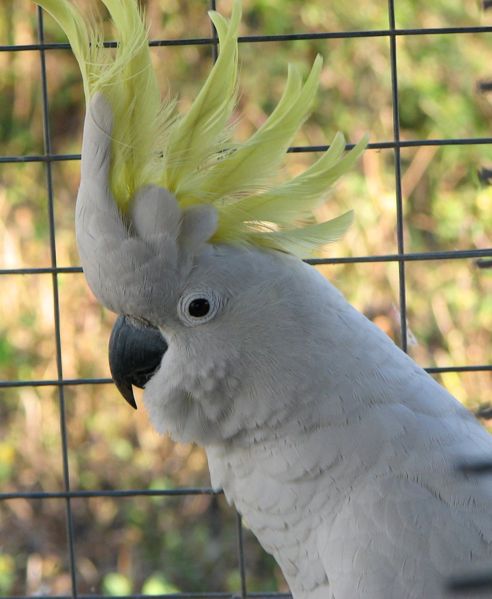 Aniruddh Patel from the Neurosciences Institute in San Diego, first saw Snowball the sulphur crested cockatoo on a video clip on the website youtube bobbing his head and tapping his feet in time to a pop song.
Aniruddh Patel from the Neurosciences Institute in San Diego, first saw Snowball the sulphur crested cockatoo on a video clip on the website youtube bobbing his head and tapping his feet in time to a pop song.
To find out if Snowball really was feeling the beat, Patel led a team who filmed Snowball dancing to Everybody by the Backstreet boys (one of snowballs favourite tunes). They measured how closely his head bobs and feet taps synchronised with the main beats of the music, and found that rather than randomly bobbing around when music is played and occasionally falling in time with the rhythm, Snowball kept time with the beat just as well as humans volunteers did. He even kept pace as the music was incrementally speeded up and slowed down without changing the pitch of the song.
A second team, also publishing in the journal Current Biology, led by Adena Schachner from Harvard University, found a similar results with another sulphur-crested cockatoo as well as an African grey parrot.
These studies support the theory that entrainment to music, otherwise known as dancing, arose because it just happens that our brains are wired up to be able to hear sounds and mimic them, something that both humans and parrots can do. Vocal mimicry requires a close link between auditory and motor circuits in the brain, and a very similar set up also allows us to respond to music with movement and dance.
Schachner's team searched through thousands of youtube clips apparently showing animals dancing, and by carrying out the same video analysis they found it was only vocal mimics that were actually keeping in time with the beat. That included 14 species of parrot and an elephant.
We are still a way off fully understanding how and why dancing and enjoying music arose in people. And maybe scientists will work out ways of testing the whether other known vocal mimics can dance, including include hummingbirds, songbirds, dolphins, seals, and some bats. But these studies have already taken us a little closer to understanding what led to us all to enjoying a good boogie on the dance floor.
You can see Snowball dancing
here.
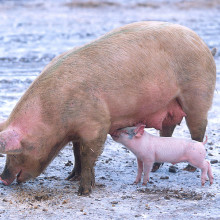
12:18 - The Genetics of Swine Flu
The Genetics of Swine Flu
with Professor Wendy Barclay, Imperial College London
Chris - Now also in the news this week, how could you have missed it, the fact that we are perhaps on the verge of a pandemic or perhaps not? People are very worried about this swine influenza from Mexico but surely more answers than any can be obtained by sequencing the virus and understanding what its genetic story is and joining us now from Imperial College in London is Professor Wendy Barclay. She is an influenza virologist. Hello Wendy!
Wendy - Hello!
Chris - Good to have you with us on the Naked Scientists. Tell us a bit about where we stand with this, what have we learned so far from looking at the genetics of this virus?
Wendy - Well, over the course of last weekend and then into last week, most of the genes of a number of different isolates of this virus has been sequenced. That information has been shared by scientists over the web, which allows us all to have a look and see whether or not this virus has got any of the particular traits that we would associate with, for example, a highly pathogenic virus that we can begin to predict, what to expect as this virus spreads into people and what sort of actually we should be preparing ourselves to take.
Chris - What about where it came from Wendy? What does the sequence actually tell us about its origins?
 Wendy - Very interesting. The swine influenza is quite a complicated beast, it turns out. Your listeners may or may not know but influenza virus has its genome splitting to eight discrete pieces known as the segments of RNA and in general, each one of those species encodes one protein although some of them encode two. So there's about 11 proteins spread on eight species and you could think of these a little bit like chromosomes if you like, that they are discrete physical entities that encode genes.
Wendy - Very interesting. The swine influenza is quite a complicated beast, it turns out. Your listeners may or may not know but influenza virus has its genome splitting to eight discrete pieces known as the segments of RNA and in general, each one of those species encodes one protein although some of them encode two. So there's about 11 proteins spread on eight species and you could think of these a little bit like chromosomes if you like, that they are discrete physical entities that encode genes.
Now we can tell by looking at those segments of RNA that way, way back some of those RNA segments were once segments of viruses that were circulating in humans and also in birds and in pigs. So what happened with swine influenza back in the late 1990s is that a particular strain appeared in the Americas which contained gene segments from at least three different viruses from three different types of hosts, humans, birds and pigs, and this constellation has been known as the 'Triple-reassortant genome' or TRIG.
That seems to be a very happy virus. It was spreading around the pigs in the Americas very well, shuffling a little bit on the outside its antigenic properties but the basic backbone of the virus seemed pretty fit. Now what's now happened is that that pig virus from the Americas has somehow muddled up with another pig virus which until recently was really only known about in Europe and the two of those have mixed together, one would imagine, in a pig which perhaps became co-infected by the two viruses and have produced this final Mexican flu.
Chris - Why do you think that this interesting combination has now suddenly decided that it's going to jump out of the pig and start infecting humans?
Wendy - Yeah, that's a super question and obviously something that we need to understand and lots of people are having to think about that the TRIG genome that was existing in the Americas since the 1990s didn't do that until now.
The insides of the virus have stayed more or less the same so the best bet is that it's the particular combination of the outside genes, the hemagglutinin and the neuraminidase, on the TRIG backbone which has allowed this jumping to occur but it's early days to say that yet and obviously that is just based on sequence gazing, what we are going to need to do now is real biology to try and understand why those surface genes, the H and the N, the particular ones come together and allow this jump to happen.
Chris - Thank you Wendy for explaining that. Could you just finally tell us what are the big priorities for virologists to now do in relation to this pandemic virus or potential pandemic virus, what would the big questions that people are now beginning to ask, be?
Wendy - Yes, well I mean obviously from a practical point of view we've got to know is this virus susceptible to antiviral drugs and will it remain so? So the good news at the moment from the gene gazing is that yes it is at the moment as far as we can see and of course we know that people are responding well to timely flu treatments but we also know that single-point mutations can render such viruses resistant.
 So we need to know, for example, will this particular virus tolerate those mutations or will there be a sort of cost to them which would mean that any resistant virus is emerged where we are unfit or no longer transmissible between people.
So we need to know, for example, will this particular virus tolerate those mutations or will there be a sort of cost to them which would mean that any resistant virus is emerged where we are unfit or no longer transmissible between people.
Another key question is whether or not vaccines that we have already can offer any sort of immunity? To be honest there's so little sequence, the homology between human strains that we have been vaccinating people against and this one, that's unlikely but we certainly need to check it out to be sure. And finally the question that is sort of big and known is whether or not this virus is going to change anymore than it has already?
We know it has managed to jump into people but is it going to stay the same as it is now or is there a chance that it could mutate and if it did mutate, could it get any more virulent or is it more likely to go the other way and sort of adapt back to it's host and live in harmony.
Chris - Well let's hope not. Thank you very much. That's Wendy Barclay who is Professor of 'Flu Biology, Virology at Imperial College in London.
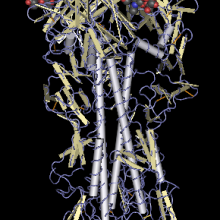
17:59 - Musical Viruses
Musical Viruses
with Stephan Zielinski, Stephan-Zielinski.com
Helen - Well it's not just science that we get from a sequence of DNA but we can also use it to generate music. Have a listen to this.
Stephan Zielinski - Swine Flu Haemagglutinin
Sounds pretty good, doesn't it? Well we've got Stephan Zielinski with us. He created this music using the sequence of amino acids in a protein in the swine flu virus called haemagglutinin and that's one that causes red blood cells to collect together. So Stephan, why make music from a virus that might trigger the next big pandemic?
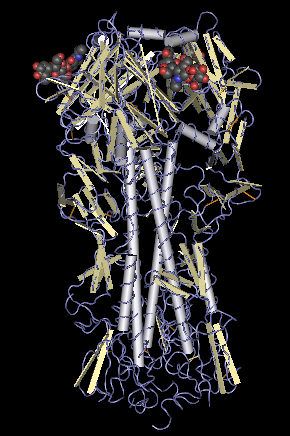 Stephan - Well I was just sitting around feeding my dancing bats on the high lithium tap water and a buddy of mine from the Mayo Clinic sent out the sequence that they had just come up with for this particular variation of hemagglutinin and I was wondering if I could translate it into something that I would have an easier time understanding and may be hear the functional groups - if I could translate them to the music then perhaps a symphony has movements so I was hoping that I could hear a division within the music between the functional groups, and I couldn't but may be other people can.
Stephan - Well I was just sitting around feeding my dancing bats on the high lithium tap water and a buddy of mine from the Mayo Clinic sent out the sequence that they had just come up with for this particular variation of hemagglutinin and I was wondering if I could translate it into something that I would have an easier time understanding and may be hear the functional groups - if I could translate them to the music then perhaps a symphony has movements so I was hoping that I could hear a division within the music between the functional groups, and I couldn't but may be other people can.
Helen - So tell us how did you get about making this piece of music?
Stephan - Well I am going to cheat and answer a closely related question which is when you listen to the music what parts of what you're hearing came from me and what parts really came from the virus? Viruses obviously don't share a lot of characteristics with music. They don't have a key, they don't have a time signature and they don't have orchestrations. So all of that stuff is things that I came up with and put into the piece itself.
What really came from the virus and all of this is the melody. Now proteins are made out of 20 amino acids in life as we know it and these 20 amino acids come in various classifications, you know a specific amino acid might be hydrophobic or it might not be. It might be aliphatic; it might be aromatic. What I did was I took the amino acids and divided them up by chemical category and assigned each category to an instrument. So for instance the piano got nine of the amino acids.
From there I sorted them by van Der Waal volume which is approximately how big the amino acid, how much space it takes up, and then by analogy to basic acoustic I assigned the large ones to relatively low notes and the small ones to relatively high notes. So when you listen to the music the interplay between the various instruments and the specific melody that's picked out, that's all come from the virus.
Helen - Excellent. Well we are certainly enjoying listening to it and it's quite a new experience for us here. So thanks Stephan. That was Stephan Zielinski and he has taken the sequence of amino acids in the swine flu virus and used it to sequence some music. You can find out more about him online at Stephan-Zielinski.com.

26:18 - Making Superalloy Jet Blades
Making Superalloy Jet Blades
with Dr Howard Stone, Cambridge University
Helen - Well planes, trains and automobiles have been consistently evolving since they were first designed and it's certainly going strong still today. Scientists and engineers are finding new ways to make transport more efficient, more renewable and safer. We are now joined by Dr. Howard Stone from Cambridge University Department of Material Sciences and Metallurgy and he is looking for ways to get the most out of metals as we use them to make jet engine blades so it can make them longer lasting, safer and more efficient. Hello Howard!
Howard - Hello!
Helen - Thanks for coming on the show. First off, what are the problems faced by jet engines that they have to overcome in order to work, to get these huge metal boxes up into the air?
Howard - Well, to actually get a gas turbine engine to work and to get the airplane in the air you actually have to suck the air in the front, compress it, mix it with fuel and then pass it out of the back over a series of turbine blades which if you like, extract the energy from the hot gases. So there are great many engineering charges in that.
 Helen - I take it we are talking very, very hot temperatures here.
Helen - I take it we are talking very, very hot temperatures here.
Howard - We are talking very, very high temperatures and certainly one of the great challenges we've got is just the great materials which are capable of surviving the environments in very core of the jet engines, and that's really the focus on the work we do.
Helen - You've got, I have to say this is very exciting, you've got a bit of a jet engine with you in studio, it doesn't look... well I don't even recognize as a piece from jet engine, what have you got there in front of you?
Howard - I have one of the turbine blades so I'll describe it for your listeners as being the size of a couple of fingers and shaped roughly like a little wing and really this is the little component which extracts a lot of the energy from the hot gases that come out of the combustor in the engine, and therefore provide lot of the power for the engine to go forward.
Helen - How is engineering that material it's made of helping to make it work and do what it needs to do?
Howard - Well these things work in an extremely demanding environment. I mean the gas stream temperatures are very, very hot and as a result we actually have to have them out of very special materials and the material I am holding here at the moment is known as a nickel based superalloy, a very apt name for it as it works on the conditions that most materials just really wouldn't survive.
Helen - What's the super alloy as opposed to just an alloy?
Howard - It's one that is capable of working at conditions that are very demanding.
Helen - Okay, and how hot are we actually talking about?
Howard - Oh, actually the gas stream temperatures these things require to work in a pretty close to or exceed their melting temperatures.
Helen - So they should actually melt if they were...
Howard - Well they are survived by some very complicated cooling passages and film coolings, ceramic coatings and so forth. To give you an analogy its equivalent to having an ice cube in an oven and actually keeping the ice cube as a nice solid chunk of ice rather than a piece of liquid water in the bottom of your oven.
Helen - So by engineering that you could essentially keep an ice cube not to melting in the middle of an oven, just by making it cool, that cooling it down.
Howard - That's a lovely analogy, yes.
Helen - Okay, wonderful and so in that particular piece you've got there, that's involved in the very core of the jets where the fuel is being burnt and that's where the thrust of the engine begins, is that right?
Howard - That's right, you've put your finger on it perfectly there. So this is the thing that extracts the energy from the hot gases that turns the big fan on the front, also it turns the various other parts of the engine which drives you through the sky, yes.
Helen - And so that presumably has to move very fast as well.
Howard - It does and it's spinning around at thousands of revolutions a minute, which is equivalent of hanging the weight for small car off each one of these little turbine blades.
Helen - Off each one of those.
Howard - Off each little blade which literally, as I said, they are more than probably the size of a couple of your fingers.
Helen - And how many of those would you get inside one jet engine?
Howard - Quite a few, quite a few.
Helen - It's certainly quite a small piece and last time I was on a plane and the jet engine looked like it was pretty huge.
Howard - They are yes, indeed.
Helen - So how do you want to make that material do what it has to do?
Howard - Well, we are really trying to make sure that the composition of the alloy is optimised so that it's stable, it can survive under these very high temperatures and one of the most interesting developments is that these things are actually made of single crystals. It's one of the few examples you will find in an engineering application where an entire component of this sort of size is actually a single crystal. Most of the things that we use to in the world around us, the steel in our cars, our cutlery and the like are made up of many little individual crystals.
Helen - So you grow one crystal in the laboratory almost...
Howard - Well it's very carefully grown to produce one beautiful single crystal.
Helen - And what does that do? How does that, what makes it work better?
Howard - That helps make sure that it survives the very high temperatures and has the best creep resistance it possibly can. So it doesn't elongate too much in the tremendous heats and tremendous stresses.
Helen - I see and so I take it that's the reason that we've got to make all these improvements in efficiency of these materials is because we are worried about in air flights increasing in numbers and the amount of emissions and so on, and is this really going to help us make flying more efficient and use less fuel and all those sort of things that we're concerned about at the moment?
Howard - That's the idea, yes. I certainly know that the increase in passenger numbers are, the government's forecast is something of the order of 495 million passengers by 2030 and that was a forecast in the 2007 report by the government and that's quite an increase in the sheer number of people. So we have to work out ways in which we can, if we fly a little more we have to work out ways in which we can make it as efficient as we possibly can.
Helen - But material science and engineering, is at the core of that, it's really at the beginning of how we get those planes in the air.
Howard - It's one of the many solutions or many tools in our armoury that we'll have to pursue to try and get the most out of these things we going to carry on relying on for many years to come.
Helen - Great. Well thanks for coming into studio. That was Dr. Howard Stone. He is from Cambridge University and he was telling us all about how the metals that are right in the heart of a jet engine can be made to actually withstand of those incredible performances to get our planes into the air.

32:38 - F1 Inspired Wheelchairs
F1 Inspired Wheelchairs
with John Bailey; Beru F1 Systems & Mike Spindle; Trekinetic
Meera - Formula-1 is the highest class of motor sport in the world. It's a fast paced world where cars can race at up to 220 mph in certain conditions but for these cars to reach these speeds and drive smoothly and safely they need to be at the forefront of science and technology. But did you know that the science behind Formula-1 is actually spilling out into other fields and even everyday life?
So this week I am at the Science Museum's Fast-forward exhibition which is showcasing just some of the products that have been implemented by Formula-1 science. I've got one of these products in front of me now and it's the Factor 001 bike by Beru F-1 systems. It has an electronic monitoring system fitted into it and John Bailey, the Managing Director of Beru F-1 Systems is here with me now. So John, as F-1 drivers are driving around, everything about them and the car's movement, speed, the driver's heart rate, it's all monitored and you are now enabling this to happen to a cyclist.
 John - Yes, typically to get the sort of data we are now getting you would have to go into a lab and spend a few hours plugged into various machines.
John - Yes, typically to get the sort of data we are now getting you would have to go into a lab and spend a few hours plugged into various machines.
Meera - But this is enabling you to get it as the cyclist is riding around on their route.
John - Yeah, exactly that. There are sort of three areas that are measured, one is the cyclist himself, one is the bike in terms of the power put into the bike and how it's being transferred to the ride, and finally the environmental conditions that those two previous categories are exposed to.
Meera - And so where would the devices be fitted on to this bike in order to measure this and how would they measure that?
John - The power measurement is taken from the cranks directly, that's where the power is actually put into the bike. That's done by from the left hand side and the right hand side in the forward and rear stroke. We also then have environmental data which is housed in the head unit, that has several accelerometers both for the bike and for the rider.
Accelerometers measure acceleration but they also measure lean angle of the bike, there's inclinometers to tell you whether you're going uphill or downhill. There are barometric pressure sensors so if you are at altitude and then the rider himself, he has a medical grade measurements of ECG, respiration rates, his bodily position relative to the bike, skin temperature and core temperature if he takes a tablet.
Meera - How are those measured?
John - They are measured by a device which is strapped to the rider's chest and within the strap there are force measurement devices which measure the expansion of his chest cavity and the rate of which that expands and there's also temperature sensors built into the strap. For the professional athletes that we are working with we have developed some wireless systems which allows coaches to monitor the data live and verbally shout at the rider if they need to.
Meera - It looks like a regular kind of bike but moving behind it now it does look extremely thin, what's it made of?
John - Everything is carbon fibre, obviously for weight and strength.
Meera - It seems to adopt the monocoque system of Formula-1 racing which is basically where there's a core body made of this carbon fibre and then everything is then attached on to it.
John - If you imagine gluing lots of parts together then ultimate weakness is where they glue together. If you've got a solid structure that isn't glued together but is a one, whole, moulded single surface then you will improve your strength and stiffness.
Meera - So it seems this monocoque structure in particular is a key design from Formula-1 racing that's being transferred into other products and it's not only bikes that it can be transferred on to but also wheelchairs, more specifically, all terrain wheelchairs. This wheelchair by Trekinetic is also on display here at the Science Museum and it does look pretty impressive so I am going to the Trekinetic base to find out more about it and see it in action.
So I am now a the production facilities of the Trekinetic wheelchairs in Hemel Hempstead and with me is the Managing Director Mike Spindle. So Mike, we've got one of the K2 all terrain model in front of us now, it's not very tall and the wheels are very thick which I am obviously assuming is going to help with the all terrain aspect of it...
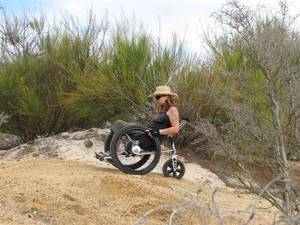 Mike - I think without doubt the main breakthrough of the chair is the fact that has what we call a monocoque chassis. That means one element, in this case the seat, is made of a super strong carbon fibre and it's to this that all the components are attached, like an F-1 car we completely dispense with the framework chassis.
Mike - I think without doubt the main breakthrough of the chair is the fact that has what we call a monocoque chassis. That means one element, in this case the seat, is made of a super strong carbon fibre and it's to this that all the components are attached, like an F-1 car we completely dispense with the framework chassis.
Meera - And it does look very comfortable. It looks as if it follows the general contours of the body and so by doing this it's supporting the right areas.
Mike - A conventional chair forces your backside into a square shape because they are all of a right angle construction so it was natural us as we are moulding it to try and make it as anatomical as we could.
Meera - I'm just going to have a seat... The seat feels very much like it's hugging my kind of hip and back area and I feel very supported.
Mike - That's right, basically your thighs, backside and sides are supported.
Meera - Attached to this chair are these large wheels which are situated at the front of the chair and I mean just pushing it around a bit it seems like a good place to actually put the wheels compared to where the wheels are on a traditional one.
Mike - When those of us that don't use wheelchair sit in an armchair our hands are at the front next to our knees and that's really where the wheels should be. One of the great benefits of this to the user is that for weak users it's easier to push but for strong users they can get up to twice normal speed.
So when we did this and we showed it to a focus group we noticed that it was really good off road and then we discovered through the focus group that the average wheelchair was completely hopeless off road and people in more chairs didn't go on gravel paths, they didn't go out in snow and they just would be limited to tarmac paths.
Meera - Now at the back of the chair you can also change the angle of that the chair is actually sitting at.
Mike - That's right, one of the problems in a wheelchair going down hills is your position in the seat changes. So if you're fine on the horizontal when you go down the hill or you could be tipped out of the chair, especially with the front wheel drive design. So we fitted a nitrogen gas shock absorber on the back which is very much like an office chair. By releasing a valve lever you can change the length of that which means you can tip the seat backwards and forwards.
Meera - Now as well as that the wheels themselves are sitting at an angle as well so the top part of the wheel is more inwards than the bottom part of it, what benefit does this provide?
Mike - Well we found that because the front wheel drive is just naturally a more efficient propulsion system, that people were getting up to, you know, strong users were getting up to quite high speeds in the chair and that led to instability off road. So what we needed was an angled wheel system where the tops of the wheels are in a position where you can reach them but that where it touches the ground they are wider apart and this is called a camber on the wheels but the real problem with it was that you've got the super sports chair that's very stable off road but when you got in a supermarket you can't get it through a doorway. So we introduced quite an innovative system of just by simply turning a shaft, you change it from negative camber to zero camber and you can get through a doorway. So we got a true dual-purpose chair.
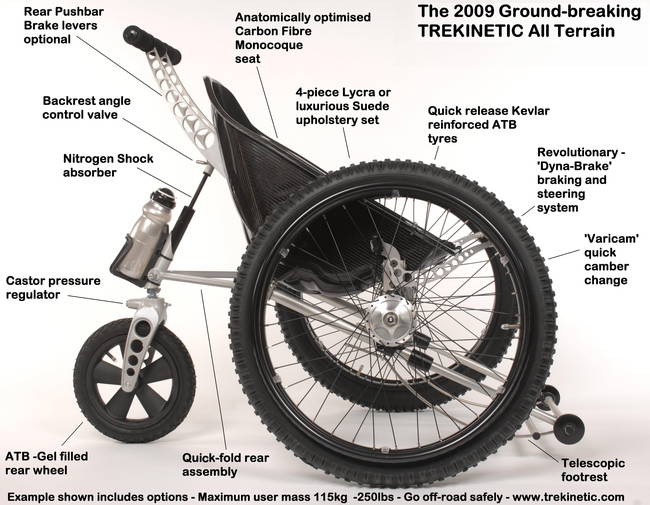
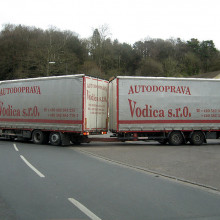
40:27 - The Science of Driving a Heavy Goods Vehicle
The Science of Driving a Heavy Goods Vehicle
with Dr Andrew Odhams, Cambridge University
Chris - We are talking about engineering, we are talking about transport and this is no exception, Andrew Odhams is with us, he's from the engineering department at Cambridge University where he has developed a very elegant solution to an age-old problem, Andrew good evening and welcome to the Naked Scientists. Good to have you with us.
Andrew - Thank you.
Chris - What was the problem you set out to solve?
Andrew - Well, it's about articulated lorries, everybody is familiar with, tractor semi-trailers as we call them, and the normal articulated lorries with three axles at the back on the trailer and a tractor with a drive axle and a steer axle, so it's five axles in all, but the front axles of the tractor obviously steer but none of the others, so we wondered what would happen if you steered the trailer axles as well and what benefits you can get to the performance of these vehicles.
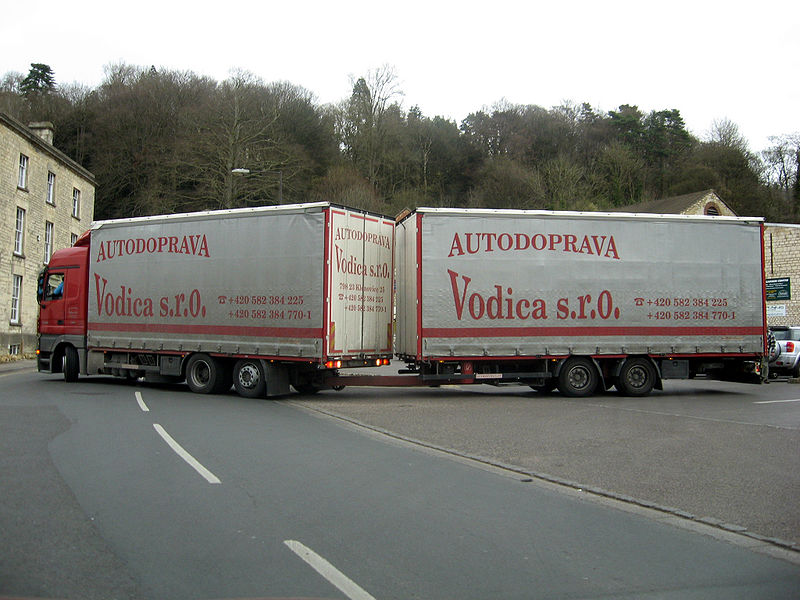 Chris - So what problems do lorry drivers face when trying to handle a lorry with that configuration at the moment?
Chris - So what problems do lorry drivers face when trying to handle a lorry with that configuration at the moment?
Andrew - Well it's two-fold. First it's low speed, their manoeuvrability and then also at high speed there are problems with these vehicles. At low speed you probably notice if you come alongside one of these vehicles on a roundabout, especially on a tight roundabout that as they go around the roundabout they start to cut in. The trailer gets further and further into the roundabout...
Chris - They mount the corner, they mount the curb... They cut you up.
Andrew - That's right, they'll mount the curb.
Chris - But it's not the driver's fault, no, you can't do anything about that, that's an engineering consequence of the way the lorry's set up.
Andrew - Exactly.
Chris - And you're saying you can make things better.
Andrew - Well if you steer the rear wheels of the trailer you can get the rear of the trailer to be further out on the roundabout. Now the steering systems do exist, low loaders have used them for a number of years but the sort of strategies people have used, the control strategies they have used to control that steering is not perfect. It emulates having a fixed axle say half way down the vehicle, the trouble with that is you get the opposite problem. When you come into a roundabout the rear of the trailer swings out and if you are a cyclist just next to that trailer you then get the trailer coming at you unexpectedly.
Chris - So basically substituting one problem for another.
Andrew - Exactly.
Chris - So what's your solution?
Andrew - So the challenge was to come up with a system with no-compromise which obviously everybody would love, and we've made ours computer controlled. It's fully active which means that we can avoid tail swing whilst minimizing cut and you can effectively get the box that's the rear of the semi trailer around the corner in the minimum space possible if you were trying to fit it, you know, if you had on a piece of paper and you are trying to fit it around the corner it's the minimum space you can possibly get it round in.
Chris - Without destroying your patent application. How does it work?
Andrew - You try and make the rear of the trailer follow where the front went so it's...
Chris - That sounds logical so what does it actually do, to do that? Does the front end know where its going, so tells the back end and the back end then sort of waits a certain amount of time and then makes the adjustment or something, is that how it works?
Andrew - Yes, probably that. You remember the path of the front hook in the computer and then it recreates it at the rear.
Chris - How does it do that?
Andrew - We have a range of sensors. It needs to know what the articulation angle is between the tractor and the semi trailer and not much more than that. It needs to know how fast it's going but not much more than that. It's relatively simple to do but you do need an active system to do it.
Chris - So would this involve then having to completely overhaul an existing lorry in order to plumb this in, could you retrofit Britain's rolling stock to accommodate your system or would a lorry have to be designed bespoke with this in mind?
Andrew - You'd have to design it bespoke. You could retrofit them but at lower performance you could retrofit into existing vehicles but trailers are changed every couple of years anyway so it's not something that's going to take ten years to roll out into a fleet if you wanted to do it.
Chris - One problem when people have tried to develop things like that in the past, correct me if I am wrong but have they not have problems with the resonance where the front of the vehicle does one thing so the back tries to copy but overcorrects and then that puts the front off which then corrects and that puts the back off which over corrects and before you know it you are sort of going all over the road and it's dangerous.
Andrew - This is where the cleverer bits come in, you know we've talked about the relatively simple bits but especially when it's going at high speed, I mentioned it briefly we're trying to correct the behaviour of the trailer when it's say doing a lane change at high speed, this is the classic thing you come across on a motorway, the driver is doing something else or not paying attention or somebody brakes heavily in front of them they have to avoid them, because they know can't stop, and you could swap into the adjacent lane but it involves doing a very severe manoeuvre with the front of the tractor semi trailer and unfortunately the dynamics of them mean, the rear does most of the manoeuvre which can cause it to roll over, you know that a tractor semi trailer will roll over before it will skid in contrast to a car.
Chris - So how do you get round that?
Andrew - Well you can control the steering, you only need a few degrees but if you can control the steering carefully enough, you can prevent this problem.
Chris - So your system is basically a very clever computer program that's watching what the front of the lorry is doing. It's feeding that back through your programme, it's speed-sensitive, to the back of the lorry and it's basically making the appropriate correction to the back of the lorry based on what the road conditions are or the travelling conditions of the tractor, the front of the lorry is doing so that you get an appropriate response at all speeds of travel.
Andrew - Yes, that would be our ideal case, yeah, and that we've...
Chris - Sounds intriguing, and taking that forward because we're little bit tight for time, just to sort of look at the applications for this, apart from making roundabouts safer when lorries go around them in towns and things, what else logically in the long-term could you do with a system like that?
Andrew - Well you can, by making a trailer more manoeuvrable and safer you can take a larger trailer into a smaller space. You could, for instance, take tractor semi trailers into the middle of town if you wanted to if you thought that was a safe thing to do you could, without endangering...
Chris - Some people do in Cambridge already out there.
Andrew - Yes, as a cyclist I have a vested interest in making them as safe as possible. But if you can get a larger trailer into a smaller space you can make it more efficient and transport-wise you know, you don't have to try and shift between tractor semi trailers and smaller trailers to skid to the middle of town.
Chris - So transport can basically become a lot more efficient.
Andrew - A lot more efficient overall, yeah.
Chris - Brilliant, thank you very much, that's Dr. Andrew Odhams. He is from the engineering department at Cambridge University with an intriguing and ingenius way to make lorries much easier to manoeuvre, and much safer too.

47:13 - Do we weigh less at night?
Do we weigh less at night?
We put this to Mark McCaughrean, Professor of Astrophysics at the University of Exeter. Your question is the question specifically whether the Moon and the Sun, the positions of them in the sky make us weigh more or less and they do a little bit. Typically the overall variation due to the positions of the Sun and the Moon might be as small as about 10 or 15 mg which is less than an aspirin so it really isn't going to make much difference. You certainly won't feel that difference in weight.
It's somewhat complicated. People have written in suggesting well, the Moon can pull to one side depending where it is and of course the Moon isn't always out at night, it's out in the daytime just as much as it is out at night but people don't tend to look. So there's a little effect there but there are much bigger effects at work.
The one that people haven't written about which is actually quite important for most people and as to do with atmospheric pressure, the atmospheric pressure will change from day-to-day, people know about highs and lows and that the typical change during a night to the high pressure zone move into a low pressure zone might actually change the weight of a person by as much as 6 grams so not 10 or 15 milligrams but 6 grams. Which is the weight of a pencil, for example. And that's all to do with the buoyancy of the air when the pressure goes up.
But the biggest way of losing weight, if you really want to lose weight quickly is to move location, move to somewhere nearer the equator where the centrifugal force or more correctly the centripetal acceleration of the earth reduces your weight because the earth is spinning and at the equator it's spinning the fastest and also going to higher altitude. You can lose as much as 300 or 400 grams that way, about half a per cent of your body weight. So if you really want to lose weight astronomically then move to Mexico City, near the equator and at high altitude. On the other hand it's probably not the best place to go at the moment...
- Previous Dancing Birds and Painless Injections
- Next Clean Air
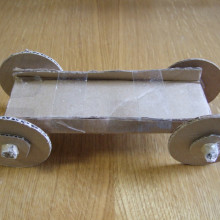









Comments
Add a comment